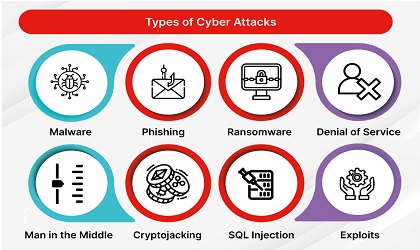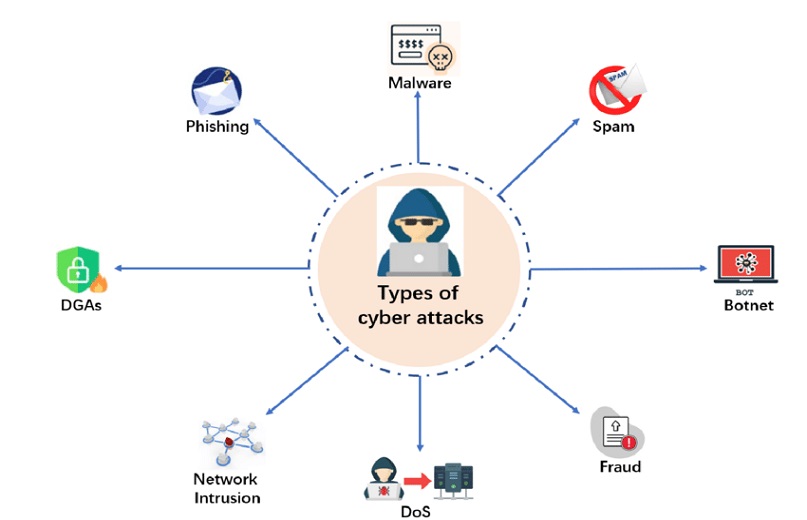In today’s increasingly interconnected world, cyber threats are growing in both frequency and sophistication. These threats can cause severe damage to individuals, businesses, and even governments, making it essential to understand the different types of cyber threats that exist. By gaining this knowledge, organizations and individuals can better defend themselves against these attacks and take proactive steps to protect their sensitive data and systems.

Here’s a look at some of the most Different types of cyber threats:
1. Malware Attacks
Malware, or malicious software, is one of the most prevalent types of cyber threats. It refers to any software designed to cause harm to a computer system, including viruses, worms, Trojan horses, and ransomware. Malware can enter a system through infected downloads, email attachments, or malicious websites. Once inside, it can steal sensitive information, corrupt files, or even lock users out of their devices, demanding a ransom for access (as seen in ransomware attacks).
2. Phishing
Phishing is a form of cyber attack that involves tricking individuals into revealing personal or financial information, such as passwords, credit card numbers, or Social Security numbers. Attackers often use email, phone calls, or fake websites to lure victims into providing this sensitive data. Phishing attacks can lead to identity theft, financial loss, or unauthorized access to sensitive systems.
3. Denial of Service (DoS) Attacks
A Denial of Service (DoS) attack aims to overwhelm a network, server, or website with an excessive amount of traffic, causing it to crash or become unavailable to legitimate users. In Distributed Denial of Service (DDoS) attacks, multiple compromised devices are used to launch the attack, making it harder to stop. These attacks can cause significant downtime for websites or services, leading to financial losses and reputational damage.
4. Man-in-the-Middle (MitM) Attacks
Man-in-the-Middle (MitM) attacks occur when a hacker intercepts communication between two parties without their knowledge. This allows the attacker to eavesdrop on conversations, steal sensitive information, or alter communication. MitM attacks are often executed through insecure Wi-Fi networks, making it important for individuals and businesses to use encryption and secure network connections.
5. SQL Injection
SQL (Structured Query Language) injection is a type of cyber attack that targets databases. Attackers exploit vulnerabilities in a website’s code to inject malicious SQL queries, giving them unauthorized access to sensitive data stored in the database. SQL injection attacks can result in data breaches, allowing hackers to steal, alter, or delete data.
6. Zero-Day Exploits
A zero-day exploit takes advantage of unknown vulnerabilities in software or hardware. These vulnerabilities are often discovered by attackers before the software developers are aware of them, leaving systems exposed until a patch is created. Zero-day exploits can be particularly dangerous because there is no defense against them until the vulnerability is addressed.
7. Ransomware
Ransomware is a specific type of malware that encrypts a victim’s files and demands a ransom to restore access. Attackers often demand payment in cryptocurrency, making it difficult to trace. Ransomware attacks can cripple businesses by locking them out of critical systems and data. In recent years, ransomware attacks have increased dramatically, affecting organizations across various industries.
8. Insider Threats
Not all cyber threats come from external attackers. Insider threats involve employees or other individuals within an organization who misuse their access to systems and data for malicious purposes. These threats can be intentional, such as theft of sensitive information, or unintentional, such as an employee accidentally exposing confidential data through poor security practices.
9. Social Engineering
Social engineering refers to the manipulation of individuals into revealing confidential information or performing certain actions, often without realizing the consequences. Phishing is one type of social engineering attack, but other tactics include impersonating legitimate individuals or creating a sense of urgency to trick victims into making mistakes. Social engineering relies on human error rather than technical vulnerabilities.
10. Advanced Persistent Threats (APTs)
Advanced Persistent Threats (APTs) involve prolonged, targeted cyber attacks on specific organizations or industries, often carried out by skilled hackers or state-sponsored groups. APTs aim to gain long-term access to systems to gather sensitive information or disrupt operations. These threats are highly sophisticated and difficult to detect, making them particularly dangerous for businesses and governments.
Protecting Against Cyber Threats
Understanding the different types of cyber threats is the first step toward building an effective defense strategy. Organizations and individuals should employ a combination of technical solutions, such as firewalls, antivirus software, and encryption, along with strong cybersecurity policies and practices, including regular software updates, employee training, and secure password management.As cyber threats continue to evolve, staying informed and vigilant is essential for safeguarding digital assets in an increasingly connected world.
Conclusion
Different Types of Cyber threats are a growing concern in today’s digital age, affecting individuals, businesses, and governments alike. From malware and phishing to sophisticated attacks like APTs and zero-day exploits, the variety of threats makes it essential to stay proactive in defending against them. Understanding the different types of cyber threats is crucial to implementing effective cybersecurity measures. By employing robust security practices, staying informed, and regularly updating defenses, both individuals and organizations can protect their data and systems from cyber criminals and mitigate potential damage. Cybersecurity is an ongoing process, and vigilance is key to staying one step ahead of attackers.
Different types of cyber threats pose significant risks in the digital landscape, making awareness essential for effective cybersecurity. By recognizing various cyber threats, individuals and organizations can better prepare their defenses and respond appropriately. Staying informed about different types of cyber threats allows for the implementation of proactive measures to protect sensitive data and systems.



